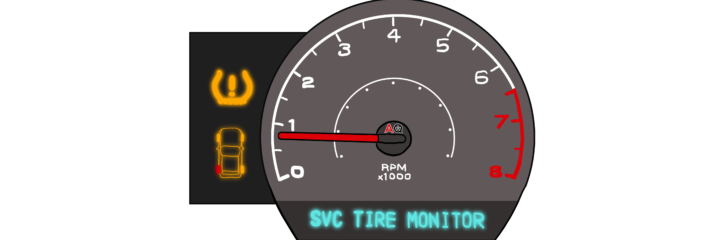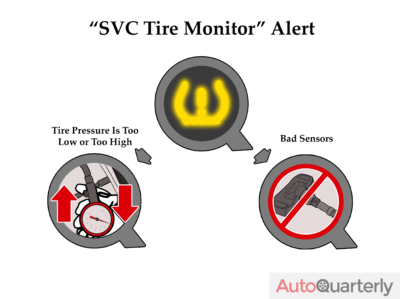The Service Vehicle Soon (SVC) Tire Monitor Alert is a warning message that pops up on your vehicle’s dashboard if there is a problem with your vehicle’s tire pressure monitoring system (TPMS) and needs to be investigated. The SVC is a “service required” warning light that usually shows up accompanied by another indicator, in this case, the Tire Monitor Alert. The TPMS monitors your tire pressure and tells you when your tire pressure is low or high or when your tire is going flat.
The TPMS carries out these functions using the TPMS sensor(s). Standard four-wheel vehicles come with four TPMS sensors, one embedded in each of the four tires. These sensors are located on the valve stem inside your vehicle’s rim. It could also be found mounted on a band wrapped around the rim on the opposite side of the valve stem. If you get an SVC tire monitor alert on your dashboard, it could mean any of these:
1. Your Tire Pressure Is Too Low or Too High
If the SVC tire monitor alert illuminates, your TPMS could be telling you your tire pressure is either too low or too high based on the recommended tire pressure of your specific car make and model.
Some car models display the individual pressures in the tires on the Driver Information Center (DIC). When you scroll through the DIC menu, it will display the pressure for the left and right front tires (L and R) and the back tires- L and R, respectively. If your tire pressure is higher than the recommended PSI, all you need to do is release some of the air from your tire to balance it up.
However, instances of too high tire PSI are rare compared to cases of too low tire pressure. In the case of low tire pressure, you will need to inflate the tire to the manufacturer’s recommended PSI. Low tire pressure could be a result of tire leaks, so inspect your tire and fix the leak if there is any. After you have fixed the leak and filled up your tires to the appropriate level, you will also need to reset your TPMS sensors to read the updated and correct PSI.
Also, if you had your tires changed or rotated recently and you didn’t reset the system to relearn the new position of your tires, the SVC tire monitor alert will come on. The reason for this is that while the TPMS could still read the PSI correctly, it will fail to correctly identify the affected tire position if your tires were rotated. You can also get the SVC tire monitor alert if the TPMS sensor was broken in the process of changing the tires. If the sensor is broken, you will need to get it replaced and the TPMS reset.
2. Bad Sensors
When the SVC tire monitor alert comes on, the TPMS will report your tire’s PSI. If it turns out that all your tires are on par with the appropriate pressure level, then one or all of the TPMS sensors are defective.
If you are dealing with a failing TPMS sensor(s), the SVC tire monitor alert light will come on and off randomly. Your car owner’s manual should have the guidelines or procedures to help you test which tire(s) may be out of synch with the tire pressure monitoring system. This way, you will be able to tell which TPMS sensor(s) is not working as it should.
To Recap
The SVC tire monitor alert is a warning to the driver that something is off with the TPMS. More often than not, the problem has to do with your vehicle’s tire pressure. This development does not necessarily have a direct impact on your vehicle’s overall performance but it is dangerous to drive a vehicle without appropriate tire pressure levels.
Plus, driving on with underinflated or overinflated tires can shorten the tires’ lifespan due to undue wear and tear. The TPMS alerts you if you have an overinflated or underinflated tire(s) so that you can adjust the inflation to the appropriate level. Doing so should resolve the issue and the alert will turn off.
If, however, the TPMS sensor(s) is defective, you will have to replace it and reset the system. While you can probably do these by yourself with the help of your car owner’s manual, it may be better to pay your local mechanic a happy visit. With the appropriate tire pressure level in all your tires, the car handles better, the fuel economy is great, and you’re safer on the road, all things considered.



